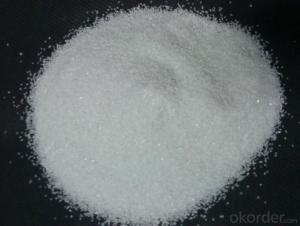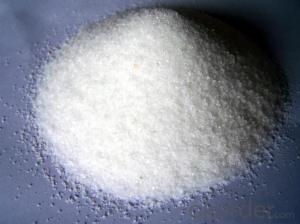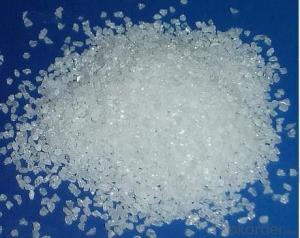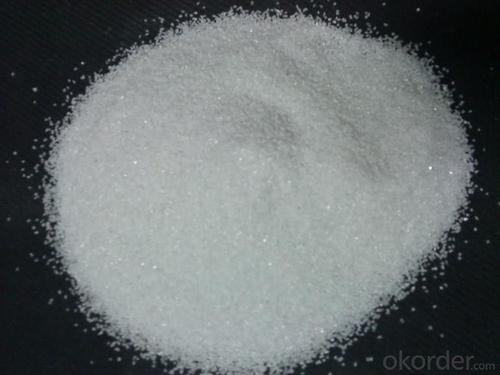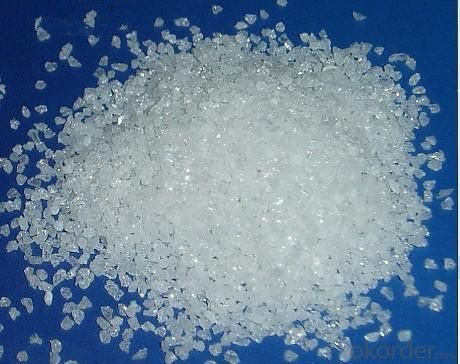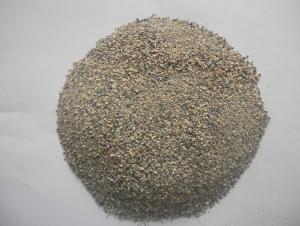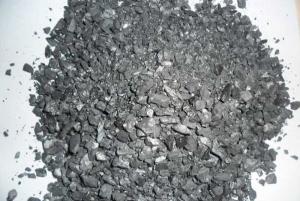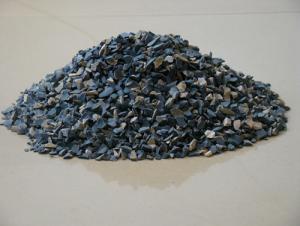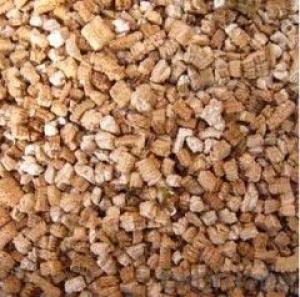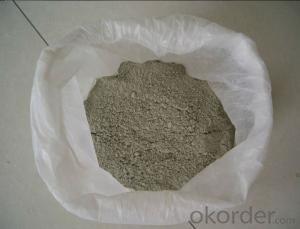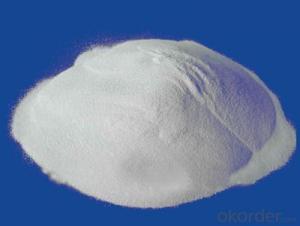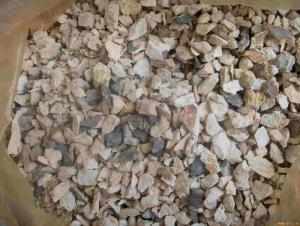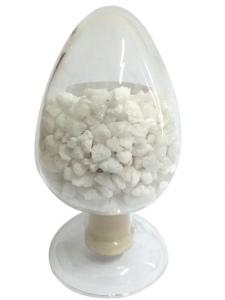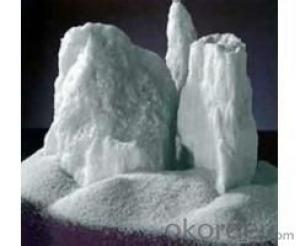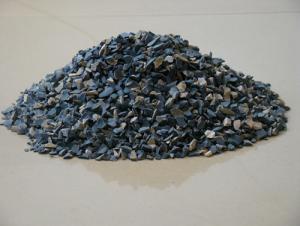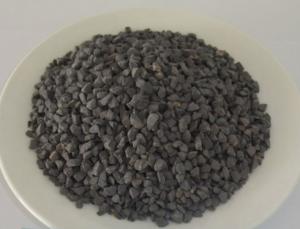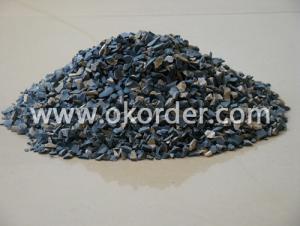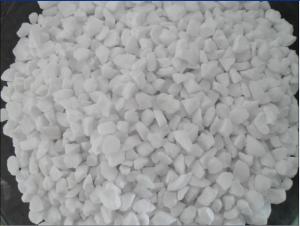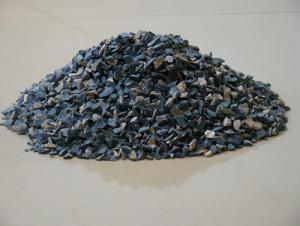White Fused Alumina 98.5 - Raw Materials for Refractory
- Loading Port:
- Tianjin
- Payment Terms:
- TT OR LC
- Min Order Qty:
- -
- Supply Capability:
- 1000MT m.t./month
OKorder Service Pledge
Quality Product, Order Online Tracking, Timely Delivery
OKorder Financial Service
Credit Rating, Credit Services, Credit Purchasing
You Might Also Like
Specification of white fused alumina
Item | B.D(g/cm3) | Apparent Porosity | Chemical Composition | |||
AL2O3 | Fe2O3 | SiO2 | NaO2 | |||
WFA | 3.7 | 7.8% | 99.2%min | 0.1%max | 0.2%max | 0.3%max |
Packaging & Shipping
In 1MT jumbo bag or as the buyer request.
We ship the cargo in 20' GP containers,each container loads 25MT/20bags.
Application of white fused alumina
1.Light-weight insulating refractories
2.Shaped and unshaped refractories
3.Pre-cast shapes and castables
4.High Alumina Refractory mixes and gunning mixes
- Q: hat kind of fire retardant materials are there
- There are many flame retardant plastics, which are modified on the basis of raw materials, such as flame-resistant ABS, flame-resistant HIPS, flame-resistant PP, flame-resistant PE, flame-resistant the PET, flame-resistant PBT, flame-resistant PC, flame-resistant PC/ABS alloy. Now there are mainly halogen flame retardant, though there are a lot of researches about halogen free flame retardant, the product stability and flame retardant effect remain to be improved. Testing methods of flame retardant materials are mainly: horizontal and vertical combustion, oxygen index method, NBS smoke box , thermal analysis, cone calorimeter, etc.
- Q: Concrete composition and function of magnesia bond used in refractory
- The first answer is 2 points, and the answer is accepted. You get a reward and 20 bonus points. Magnesia, magnesia brick, magnesia brick, magnesia brick, magnesia calcium brick, magnesia carbon brick
- Q: Who knows the fire resistant level of the rock wool color plate?
- Hello; Same with other unprotected steel, the fire endurance of the color steel?plate is generally 15 minutes. It is not a fireproofing material, let alone fire resistant level. If the color steel plate has sprayed fire retardant coating and the thermal insulation filling material in the core is rock wool fiber, it can achieve A level fireproofing requirements. The color steel?plate refers to the painted steel plate, which is a steel plate with organic coating. The color steel board is divided into the single plate, color steel composite board, floor support board, ect. It is widely used in large public buildings, public plants, portable dwelling, and integrated housing walls and roofings. I hope that will help you.
- Q: How should refractory cement be used?
- How to use refractory cement? How to use refractory cement? Thank you.
- Q: What are the requirements for the performance of refractory materials?
- Refractory materials should have very high refractoriness, high temperature heat load and resistance to softening, melting; with high volume stability, resistance to high temperature and heat load, volume shrinkage and only uniform expansion; high strength at room temperature and high temperature strength, high load softening temperature, under the joint action of heat load and heavy load, no loss of strength, creep collapse; Electric furnace analysis should have good resistance to thermal shock, resistance to rapid temperature changes, no crack, not flaking; with excellent slag resistance.
- Q: What is shapeless refractory with high performance?
- The popular ones are: Non-cement fine powder bonded castable is a functional refractory castable with nano material introduced.
- Q: What are the differences between thermal?insulation?material and refractory?
- Just as its name implies, Thermal insulation means that it doesn't conduct heat instead it insulates heat inside, while refractory means resistance to high temperature and it will not be out of shape or damaged due to high temperature.
- Q: Introduction to refractory material
- Refractory material refers to inorganic non-metallic materials with refractoriness of no less than 1580℃. Refractoriness refers to the centigrade temperature of refractory cone sample in the case of no load when resisting high temperature without softening. But the refractoriness alone cannot descript the refractory material, thus 1580℃ is not absolute. Now refractory material is defined as material used in high temperature allowed by its chemical properties. Refractory material is widely used in metallurgy, chemical industry, petroleum, machinery manufacturing, silicate and power industrial area, of which the application in metallurgy accounts for the largest part of 50% ~ 60% of total output.
- Q: Who knows about the types of Dalian thermal insulating and refractory materials?
- (1) rock wool board: the heat conductivity coefficient is 0.041-0.045. It is fire retardant, has a great temperature absorption while a poor thermal insulation performance. (2) glass wool: it is simple in construction and free in cutting. It has advantages of antibiosis, mould proof, aging resistance and anticorrosion, and can ensure a healthy environment. It has a low hygroscopicity and a stable physical property. (3) expanding polystyrene board(EPS board): thermal conductivity: 0.037-0.041, it has a good thermal insulation performance, cheap price but a poor intensity. (4) extruded polystyrene board(XPS board): thermal conductivity: 0.028-0.03, it has a better thermal insulation performance, high intensity, moisture resistance while it is expensive, and requires surface treatments during construction. (5) gelatine powder polyphenyl granule heat insulating slurry: heat conductivity coefficient: 0.057-0.06, it has a good flame resistance while a poor thermal insulation performance, as well as has high construction requirements and can be recycled. (6) polyurethane foam: heat conductivity coefficient: 0.025-0.028, it has advantages of waterproofness, thermal insulation, high intensity, high integrity, and good integrity, but it has a poor fireproof?performance and is more expensive. (7) rigid polyurethane: heat conductivity coefficient: 0.018-0.023, it has advantages of low heat conductivity coefficient and good thermal performance. When the unit weight of rigid polyurethane is 35 to 40kg per cubic meters, it is equivalent to half of the EPS. It is the one with the lowest heat conductivity coefficient among all the thermal insulation materials. (8) perlite slurry: heat conductivity coefficient: 0.07-0.09, it has advantages of fire and high-temperature resistance, and high water absorption but is poor in thermal insulation.
- Q: What is glass furnace used high-grade refractory materials?
- It is said that building a furnace need 30 million? After the ignition, it can't be gone out. Only at the waste to maintenance?
Send your message to us
White Fused Alumina 98.5 - Raw Materials for Refractory
- Loading Port:
- Tianjin
- Payment Terms:
- TT OR LC
- Min Order Qty:
- -
- Supply Capability:
- 1000MT m.t./month
OKorder Service Pledge
Quality Product, Order Online Tracking, Timely Delivery
OKorder Financial Service
Credit Rating, Credit Services, Credit Purchasing
Similar products
Hot products
Hot Searches
Related keywords
